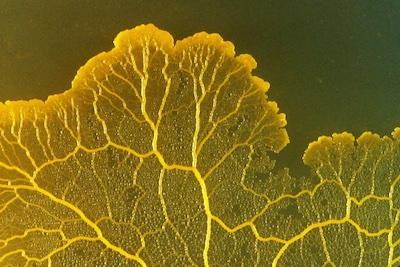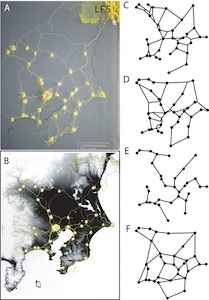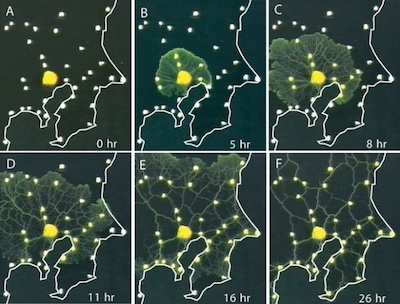Imagine a sprawling urban landscape, bustling with commuters streaming through arteries of steel and glass. Now, picture a creature, with no brain or nervous system, weaving a network of slimy tubes that eerily mirrors the very veins of human travel. This is the story of the Tokyo Metro and the humble slime mold, Physarum polycephalum - a tale of biomimicry, optimization, and nature's hidden hand in shaping our world.

Physarum polycephalum slime mold
In 2010, Japanese researchers set out to understand how Physarum navigates its world. They scattered oat flakes on a petri dish, mimicking the location of major cities around Tokyo, and watched as the slime mold responded. In its relentless quest for sustenance, the mold sprouted a network of pulsating tubes, connecting the oat flakes with stunning efficiency.

Slime mold network mimicking Tokyo Metro Line
The result? A map that bore an uncanny resemblance to the sprawling Tokyo Metro, with its central hubs, branching lines, and optimized routes. This wasn't mere chance. The slime mold, through its decentralized decision-making, had stumbled upon the shortest and most efficient way to connect all the food sources.
This experiment became a landmark in the field of biomimicry - the practice of imitating nature's designs to solve human problems. The slime mold's network provided invaluable insights into optimization algorithms, offering potential applications in transportation systems, logistics, and even computer networks.
The Tokyo Metro may not have been directly designed by a slimy genius, but the experiment's legacy goes far beyond. It highlighted the remarkable problem-solving abilities of simple organisms and opened doors to a new approach to network design. By learning from nature's wisdom, we can create systems that are not only efficient but also resilient and adaptable, just like the intricate veins of a slime mold.

The progression of the fungus in its network through oat flakes
So, the next time you navigate the labyrinthine tunnels of the Tokyo Metro, spare a thought for the unsung hero - a brainless blob that, in its quest for a few oats, showed us the secrets of optimized pathways, forever changing the way we view network design.
This story offers a glimpse into the incredible potential of biomimicry, reminding us that the solutions to some of our biggest challenges might just lie in the smallest and most unexpected corners of the natural world. It's a tale of humble beginnings, unexpected insights, and the power of nature to inspire innovation, leaving us both intrigued and hopeful for the future of bio-inspired design.
Source:
Discover Magazine Blog: "Brainless Slime Mold Builds a Replica Tokyo Subway (Discover KK, 2010)"
AsapScience YouTube Video: "How a Slime Mold designed the Tokyo Railway System (2010)"
Phys.org News Article: "Could a virtual slime mould design a better subway system? (2016)"